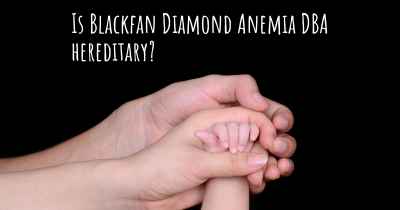What is the history of Blackfan Diamond Anemia DBA?
When was Blackfan Diamond Anemia DBA discovered? What is the story of this discovery? Was it coincidence or not?

Blackfan Diamond Anemia (DBA) is a rare inherited blood disorder characterized by a failure of the bone marrow to produce enough red blood cells. This condition was first described in 1936 by two pediatricians, Dr. Louis K. Diamond and Dr. Kenneth D. Blackfan, hence the name.
Dr. Diamond and Dr. Blackfan were studying a group of children who presented with severe anemia and other related symptoms. They noticed that these children had a specific type of anemia that was different from other known forms at the time. The doctors published their findings, describing the condition as a distinct entity and naming it Blackfan Diamond Anemia.
Blackfan Diamond Anemia is a genetic disorder that primarily affects the production of red blood cells. Red blood cells are responsible for carrying oxygen throughout the body, and a deficiency in their production leads to anemia. The exact cause of DBA was unknown for many years, but advancements in genetic research have shed light on its origins.
Scientists have discovered that most cases of DBA are caused by mutations in certain genes that are involved in the production of ribosomes, the cellular structures responsible for protein synthesis. These mutations disrupt the normal development and maturation of red blood cells, leading to their reduced production.
Symptoms
The symptoms of DBA usually appear within the first year of life. Infants with DBA often present with severe anemia, which can cause pale skin, fatigue, and weakness. They may also have a failure to thrive, meaning they do not gain weight or grow at the expected rate. Other symptoms can include craniofacial abnormalities, such as a small head or widely spaced eyes, and malformations of the hands and arms.
Treatment
Historically, treatment options for DBA were limited. Blood transfusions were commonly used to manage the anemia, but they came with their own set of complications and risks. In the 1980s, the use of corticosteroids, such as prednisone, became a standard treatment for DBA. These medications can stimulate red blood cell production in some patients, reducing the need for transfusions.
More recently, advances in medical research have led to the development of alternative treatment options for DBA. One significant breakthrough is the use of stem cell transplantation, also known as bone marrow transplantation. This procedure involves replacing the patient's faulty bone marrow with healthy stem cells from a compatible donor. Stem cell transplantation can provide a long-term solution for DBA, potentially eliminating the need for ongoing transfusions.
Research and Future Outlook
Research into Blackfan Diamond Anemia continues to expand our understanding of the disorder. Scientists are investigating the underlying genetic mutations and the mechanisms that lead to impaired red blood cell production. This knowledge may pave the way for targeted therapies that can correct the genetic defects and restore normal blood cell production.
Additionally, advancements in gene therapy hold promise for the treatment of DBA. Gene therapy involves introducing healthy copies of the mutated genes into the patient's cells to correct the underlying genetic defect. While still in the experimental stages, gene therapy has shown potential in preclinical studies and may offer a future treatment option for individuals with DBA.
In conclusion, Blackfan Diamond Anemia is a rare genetic disorder that affects the production of red blood cells. It was first described by Dr. Louis K. Diamond and Dr. Kenneth D. Blackfan in 1936. The condition primarily manifests in infancy and is characterized by severe anemia and other associated symptoms. Treatment options have evolved over time, with corticosteroids and stem cell transplantation offering hope for affected individuals. Ongoing research into the genetic basis of DBA and advancements in gene therapy provide optimism for improved treatments in the future.








